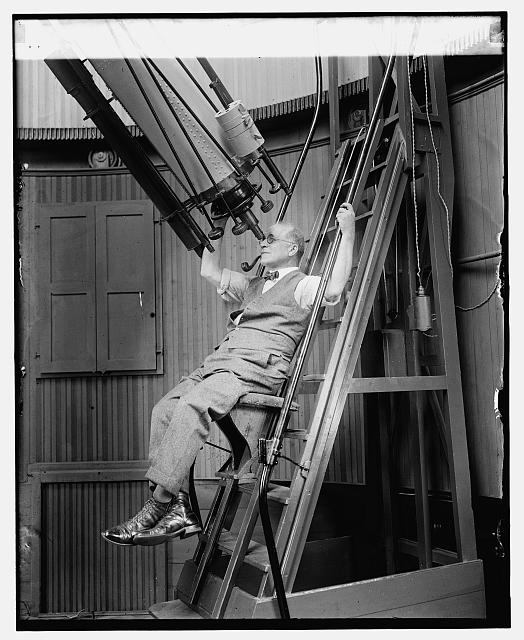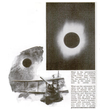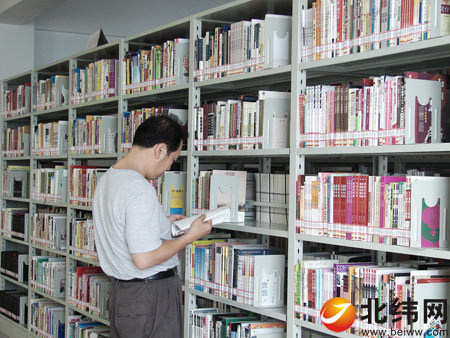In 1919, one eclipse chaser wanted to mount a telescope on a seaplane
“What can the astronomer do, when, just as the moon is about to obscure the sun during a total eclipse, a cloud intervenes?” Popular Science posed such a dilemma to its readers in a 1919 solar eclipse story. “Pack up and go home” was the answer for the average eclipse viewer. But even in 1919 extreme eclipse chasers had contingency plans.
The moon’s full shadow hurtles across the Earth at a breakneck 1,500 mph roughly every 18 months. By a twist of cosmic fate unique in our solar system, our planet’s one and only moon happens to be the right size and distance to completely block the sun’s face, briefly exposing its corona, creating a spectacular sight. But that complete overlap only happens in a narrow path about 100 miles wide—the path of totality.
Extreme eclipse chasers, who call themselves umbraphiles, will seek that path whenever it comes around, even to the remotest regions of Earth. Since the path carved by the moon’s shadow typically traverses thousands of miles—across oceans and continents—the goal is to pick a destination known for its cloudless skies.
Kelly Korreck, NASA’s program manager for the 2024 solar eclipse, which will speed across the US from Texas to Maine on April 8, has viewed eclipses from places as different as the deck of a US aircraft carrier (USS Yorktown) and the northern Chilean coast. For Korreck, the experience is incomparable. “Very strong emotions come up,” she says, “from almost fear that the sun has gone away to something very magical and very exciting.” As soon as it’s over—totality only lasts several minutes or less, location dependent—she admits that her immediate thought is, “When’s the next one? Where are we going to go?”

In 1919, jetting across the world was not yet possible, and less of the planet was developed and accessible. Eclipse chasers were mostly well-funded scientists and astronomers who had the wherewithal to mount an expedition, set aside months for travel, and haul tons of equipment into remote regions. That’s why one astronomer’s plan in 1919 to mount a telescope on a seaplane and fly above the clouds seemed worth reporting, even though Popular Science’s editors were skeptical that it would work. The alternative, “unmanned balloons” fitted with cameras, proposed by George Hale, founder of the Mount Wilson Observatory in California, seemed much more practical.
Whether the daring aeronautical astronomer, David Todd, an eccentric eclipse chaser and erstwhile professor at Amherst College, ever succeeded with his seaplane plan isn’t recorded. But the 1919 eclipse went down in the history books for its role in providing the backdrop for Arthur Eddington and Frank Dyson to prove Einstein’s theory of relativity.
Today, NASA operates dozens of heliophysics missions, most from space-based observatories, free from the chance of cloudy skies.

A total eclipse of the sun can never last more than eight minutes. Usually it lasts much less. An astronomer will travel thousands and thousands of miles to an out-of-the-way place, in order to make the most of a few precious minutes. The actors in a play are no more carefully rehearsed than are astronomers stationed at the various instruments. No one member of an eclipse expedition sees the eclipse as a whole; each one performs the special duties assigned to him.
What if cloud or fog should steal between the earth and the sun? What if it should rain? All these elaborate preparations, all this tedious traveling, go for nothing. But fogs are always low-lying—never more than a thousand feet thick. Therefore, if cloud or fog creep in between the earth and the sun, the solution is to climb above them and see the eclipse in all its uncanniness.
No wonder, then, that astronomers are interested in the experiment undertaken by Professor David Todd, of the Amherst College Astronomical Observatory, of using a seaplane in which to rise high above the clouds to view the eclipse.
Professor Todd’s Experiment
With the assistance of United States Naval officers and a seaplane, Professor Todd set out to take photographs of the sun’s eclipse which occurred on May 29. It was planned that the steamship on which the expedition sailed would stop at a point near the equator off the South American coast, launch the seaplane, and then stand by while the astronomer tried out his plan.

It might have been expected that Professor Todd would be the first to carry astronomy into the air. He is the most enthusiastic, indefatigable, and ingenious of eclipse observers. He even went so far, some years ago, as to devise a method of operating a whole battery of astronomical instruments from a central point, but was unable to employ his invention for the observation of this particular eclipse because the sky was at the time obscured.
Although at the time of going to press the results of Professor Todd’s experiment have not been reported, it may be doubted that the plan of using a seaplane is practicable. Such is the vibration caused by a seaplane’s engine that the steady platform that must be provided for all telescopes becomes a shaking base hardly suitable for Professor Todd’s purpose. To be sure, it was his intention to offset the vibration by an elastic mounting of the telescope; but anyone who knows anything at all about the inertia of movable parts will admit that absolute steadiness can hardly be thus obtained.
A More Practical Scheme
Professor George E. Hale, of Mount Wilson Observatory, has a far more practical scheme, to our mind. His plan is to send an unmanned balloon above the clouds, and to steady the cameras, which the balloon will carry, by means of a gyroscope. Professor Hale plans to study the corona—that ghostly appendage which surrounds the sun, and which is visible from the earth only during an eclipse—at any time.
As we ascend in the atmosphere of the earth we finally reach a point, perhaps at an altitude of thirty miles or more, where the sky is not blue, but jet-black.
The sky is blue because the air is filled with countless billions of dust particles that diffuse the light of the sun. In the inky canopy of the sky above the region of dust particles, where the air is extremely thin, the stars appear in their proper places even in broad daylight. And the sun is a great blazing ball hung in the blackness. Its wonderful corona, the chief object of study during a total eclipse, gleams in all its pearly beauty.
Should Professor Todd Succeed
If Professor Hale succeeds in realizing his plan, we need not wait for a total eclipse in order to study the corona but we can photograph it whenever we please and study it day by day.
(责任编辑:行业动态)
-
Google is bringing AI summaries to ‘Files’ so you can find your docs quicker
 Google is full speed ahead on AI-powered features for Android devices, and a new summarization tool
...[详细]
Google is full speed ahead on AI-powered features for Android devices, and a new summarization tool
...[详细]
-
 雅安日报讯 7月29日,汉源县清溪镇中心小学一片欢声笑语,湖北工业大学艺术设计学院2009年暑期社会实践赴汉源小分队,将师生捐赠的5000元现金与价值近2000元的学习生活用品,带给了清溪镇中心小学
...[详细]
雅安日报讯 7月29日,汉源县清溪镇中心小学一片欢声笑语,湖北工业大学艺术设计学院2009年暑期社会实践赴汉源小分队,将师生捐赠的5000元现金与价值近2000元的学习生活用品,带给了清溪镇中心小学
...[详细]
-
 雅安日报讯 昨15)日,中国红十字会常务副会长江亦曼率领的督导组一行到我市进行红十字会灾后恢复重建项目督导。江亦曼在肯定我市红十字会系统灾后恢复重建工作的同时,要求要把确保项目质量放在首位,严格资金
...[详细]
雅安日报讯 昨15)日,中国红十字会常务副会长江亦曼率领的督导组一行到我市进行红十字会灾后恢复重建项目督导。江亦曼在肯定我市红十字会系统灾后恢复重建工作的同时,要求要把确保项目质量放在首位,严格资金
...[详细]
-
 市图书馆藏书丰富 “全民阅读,建设书香雅安”活动启动以来,有关部门对我市诸多重要的阅读场所进行了大力改造和完善,“读书热”正在我市各地渐渐蔓延开来。 城里有书香 10日,记者走进市区人民路一家书店,畅
...[详细]
市图书馆藏书丰富 “全民阅读,建设书香雅安”活动启动以来,有关部门对我市诸多重要的阅读场所进行了大力改造和完善,“读书热”正在我市各地渐渐蔓延开来。 城里有书香 10日,记者走进市区人民路一家书店,畅
...[详细]
-
14 Heists, Robberies, and Other Great Capers
 In the dark hours of the morning on Monday, November 25, 2019, five masked men broke into the Green
...[详细]
In the dark hours of the morning on Monday, November 25, 2019, five masked men broke into the Green
...[详细]
-
 2008年6月,104名雅安农民工抵达北京。他们将为北京奥运会场馆和相关道路提供清洁保障。在一年的合同期内,这批经过严格培训的雅安工人出色地完成了工作,获得了赛会环卫中心的好评。他们,仅仅是雅安劳务输
...[详细]
2008年6月,104名雅安农民工抵达北京。他们将为北京奥运会场馆和相关道路提供清洁保障。在一年的合同期内,这批经过严格培训的雅安工人出色地完成了工作,获得了赛会环卫中心的好评。他们,仅仅是雅安劳务输
...[详细]
-
 本报讯生活中随时都在发生着非常神奇的事,有心的人往往能发掘出来。比如昨天,2009年8月7日,一个看似普通的日子,就被网友找到了不同之处——09年8月7日,12时34分56秒。昨天中午,市民小钟打开电
...[详细]
本报讯生活中随时都在发生着非常神奇的事,有心的人往往能发掘出来。比如昨天,2009年8月7日,一个看似普通的日子,就被网友找到了不同之处——09年8月7日,12时34分56秒。昨天中午,市民小钟打开电
...[详细]
-
 昨10)日,雅安—眉山—资阳—遂宁线以下简称“雅眉资遂线”)铁路项目规划座谈会在我市召开。副市长朱玉贵参加座谈会。 朱玉贵说,《西部综合交通枢纽建设规划》将我市列为西部综合交通枢纽的区域性次级枢纽,
...[详细]
昨10)日,雅安—眉山—资阳—遂宁线以下简称“雅眉资遂线”)铁路项目规划座谈会在我市召开。副市长朱玉贵参加座谈会。 朱玉贵说,《西部综合交通枢纽建设规划》将我市列为西部综合交通枢纽的区域性次级枢纽,
...[详细]
-
 患者制作香囊“这是我们自己做的香囊,有安神助眠、除湿等功效,价格不贵,10元钱一个。”8月14日,雅安市第四人民医院门诊大厅的“爱心义卖”吸引了医院里不少人的目光。售卖香囊的是该院精神康复科的患者,售
...[详细]
患者制作香囊“这是我们自己做的香囊,有安神助眠、除湿等功效,价格不贵,10元钱一个。”8月14日,雅安市第四人民医院门诊大厅的“爱心义卖”吸引了医院里不少人的目光。售卖香囊的是该院精神康复科的患者,售
...[详细]
-
 原鸡原味,皮脆肉嫩!8月11日直播带您了解胡须鸡新吃法_南方+_南方plus惠州龙门胡须鸡,又称龙门鸡、三黄胡须鸡,颔下有发达而张开的羽毛,状似胡须而得名。惠州龙门胡须鸡作为中国原鸡,它历史悠久,记于
...[详细]
原鸡原味,皮脆肉嫩!8月11日直播带您了解胡须鸡新吃法_南方+_南方plus惠州龙门胡须鸡,又称龙门鸡、三黄胡须鸡,颔下有发达而张开的羽毛,状似胡须而得名。惠州龙门胡须鸡作为中国原鸡,它历史悠久,记于
...[详细]

 非瘟时代家庭农场养猪的出路?
非瘟时代家庭农场养猪的出路? 交警提醒:雨天驾驶需谨慎
交警提醒:雨天驾驶需谨慎 评论:雅安市花,你心属谁?
评论:雅安市花,你心属谁?